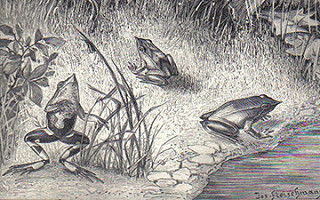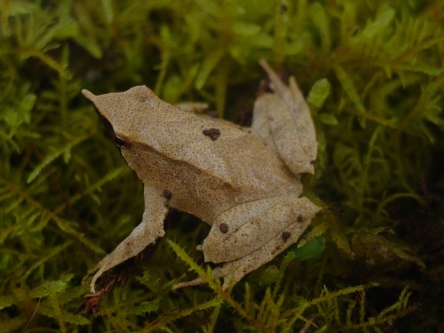
Rhinoderma rufum
Super amphibian parents, but don’t hold your breath about seeing one.
We used to think the Chile Darwin’s frog (also known as the Northern Darwin’s frog) was a localised variety of Darwin’s frog (Rhinoderma darwinii), but we now know it is a seperate species. They have only been recorded in central Chile. As the name suggests, these frogs were discovered by renowned naturalist Charles Darwin on his famous voyage on HMS Beagle. They are small, only about 31mm long, and can vary in colour from brown to various shades of green. They are what is known as a sit-and-wait predator, hiding in the leaf litter until a tasty looking insect strays into hopping distance.
The most distinctive feature of these little frogs is the fleshy protrusion on their face. It gives their head a triangular shape and may help with camouflage; this shape coupled with their variety of colours makes them look a bit like a dead leaf. This protects them from predators like snakes and birds, and even rodents have been known to eat them.

The two species of Darwin’s frog are known as mouth-brooding, and are the only two amphibians to employ this rather unusual parenting technique. Females lay a clutch of 12-24 eggs and then leaves them; the male fertilised and guards them. When the tadpoles begin moving in the eggs, the males scoops them up…and swallows them! They are kept in the males vocal sac until they can eat by themselves. The male then spits them out in a body of water, where they turn into froglets and finally adult frogs. Here is a video of an R. darwinii regurgitating his young (in this species the tadpoles become froglets while still inside).
Sadly, there’s bad news about this amazing amphibian. The last confirmed sighting of a Chile Darwin’s frog was in 1980. The scientific community suspects they have gone extinct and the reason is not clear It could be to do with habitat destruction, but this is unlikely to explain it fully. For several years not amphibian species across the world have been threatened by an infection caused by chytrid fungus. It kills amphibians by affecting the skin and stopping the animals absorbing salts, which they need to keep their heart pumping (read more about this here).

R. darwinii (Non-copyrighted pictures of extinct animals are hard to find)
It might be too late for the Chile Darwin’s frog, but organizations around the world are trying to find out more about chytrid fungus and how we can combat it. In 2015 scientists from ZSL, the National Museum of Natural History in Spain and Imperia College London published the results of a 7-year study that found it’s possible to treat tadpole with anti-fungal medication and stop chytrid in an area (read more about ZSL’s work here). You can also visit Amphibian Ark to learn about international efforts to control this disease.
Next week, an invertebrate. That’s a plant. That lives in the sea. Good luck deciphering that one.